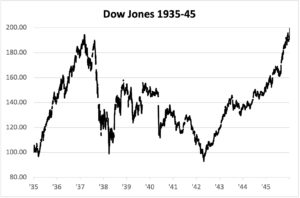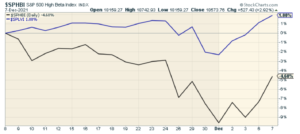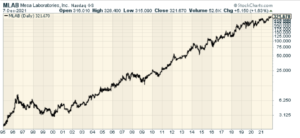CWS Market Review – December 7, 2021
(This is the free version of CWS Market Review. I’m going to unveil our 2022 Buy List on December 24. To see the new list, make sure you’re a premium subscriber. You can get the premium newsletter for $20 per month or $200 for the whole year.)
Pearl Harbor: 80 Years Ago Today
Eighty years ago today, the Japanese military attacked Pearl Harbor which brought the United States into World War II. Many others have memorialized the event far better than I could. For my part, I want to look at how the financial markets reacted to that terrible day.

While the United States was at peace on December 7, its stock market was not in good shape. Since December 7th was a Sunday, the stock market was closed, but the day before, the Dow closed at 116.60. (The NYSE had a brief Saturday trading session into the 1950s.)
That was well below its peak from four years before. In March 1937, the Dow peaked at 194, and later that year, the bottom fell out. We tend to think of the Great Depression as one long recession but that’s not quite right. After several attempts to get the economy out of its depression, the economy crashed again in 1937.
From August to November 1937, the market suffered one of its sharpest drops on record. The 1937 crash may also be one of the most forgotten. Since it’s so close to 1929, the 1937 mess probably gets lost in the shuffle. Still, the Dow crashed 40% in just three months. From May 1937 to June 1938, the unemployment rate rose from 14.3% to 19.0%.
Things didn’t get much better. In May 1940, the market crashed again as the Germans marched into Paris. (“I remember every detail. The Germans wore gray, you wore blue.”). From May 11 to May 21, the Dow lost 21%.
We should also remember that stock investing hadn’t reached the middle class yet. ETFs and 401(k) plans were still many years away. The Great Depression scared away many potential investors. It took years to convince Americans that the stock market was a sound part of a financial plan.
By December 7, 1941, the market was still far below its 1929 peak. The Dow was 69.4% below where it had been 12 years before. Can you imagine investing for 12 years and still being that far in the hole? For us to say the same for today, the Dow would have to be at 2,850 instead of 35,700.

The market didn’t respond well to the attacks. On Monday, December 8, the Dow fell 3.50%. The selling continued into Tuesday as the Dow lost another 2.89%. As the reality of full mobilization set in, the market continued to fall. By April 28, the Dow reached its low of 92.92. That was ten days after Jimmy Doolittle’s daring raid over Tokyo.
Measuring from December 6, this was a drop of 20%. That was already on top of a lousy market. After 12.5 years, the Dow was still less than one-quarter of its September 1929 peak. You can see why so many members of the Greatest Generation were wary of financial institutions.
The government soon mobilized America for all-out war. That included our finances. The Federal Reserve reached a deal with the U.S. Treasury to buy Treasuries at a yield of 3/8 of 1%. The reserve banks dropped their interest rates to 1%. Americans bought bonds to fund the war.
In October 1942, Franklin Roosevelt issued Executive Order 9250 which limited incomes to $25,000 a year.
7. In order to correct gross inequities and to provide for greater equality in contributing to the war effort, the Director is authorized to take the necessary action, and to issue the appropriate regulations, so that, insofar as practicable no salary shall be authorized under Title III, Section 4, to the extent that it exceeds $25,000 after the payment of taxes allocable to the sum in excess of $25,000. Provided, however, that such regulations shall make due allowance for the payment of life insurance premiums on policies heretofore issued, and required payments on fixed obligations heretofore incurred, and shall make provision to prevent undue hardship.
Yes, this really happened.
Four years after Pearl Harbor, the Dow closed at 194.08. That’s a gain of two-thirds in just four years.
As it turned out, the April 1942 low was a historic buying opportunity. The stock market rallied almost continuously for the next 25 years. The American post-war economy was a boom for both the rich and poor. By May 1965, the Dow was up tenfold from its 1942 low.
The Stock Market Turns Defensive
Now let’s turn our attention to the current stock market. Today, the S&P 500 closed higher by 2.07%. It was the best day for the index since March and the second-best day all year.
The S&P 500 has now closed up or down by more than 1% in seven of the last eight sessions. That didn’t happen once in the 29 sessions prior to that.
From November 18 to December 1, the S&P 500 lost just over 4%. In the last four sessions, the index has made back more than 90% of what it lost. On an intra-day basis, the S&P 500 had a drawdown of 5%. This was our 29th such drawdown since 2009.
What’s stood out in the recent market is how defensive it’s been. By that, I mean that low volatility stocks have done much better than so-called high beta stocks. Here’s a chart of the S&P 500 High Beta Index (in black) along with the S&P 500 Low Vol Index (in blue).

Except for the last two days, the low volatility stocks have done much better while the high beta stocks have suffered the most pain.
That’s a big change from the dynamics that had ruled the market. What happened is that the Fed’s aggressive policies virtually eliminated risk from stock investing. As a result, all the risky asset classes took off. From March 2020 to June 2021, the S&P 500 High Beta Index tripled. Meanwhile, the S&P 500 Low Volatility Index gained just 35%.
Now that the Fed is shifting gears, some of that risk tolerance is shifting as well. Suddenly boring stocks are popular. For example, both Facebook (FB) and Tesla (TSLA) are 15% off their highs. The ARK Innovation ETF (ARKK), which holds many emerging growth stocks, is over 37% below its 52-week high.
Meanwhile, many fairly dull yet stable stocks are at new highs. This includes Abbott Labs (ABT), Procter & Gamble (PG) and McDonald’s (MCD). Hershey (HSY) and AFLAC (AFL) came close to new highs today.
A few times this year, there’s been a shift away from risk, but each time, the trend has petered out. This time may be different.
Stock Focus: Mesa Laboratories
This week’s stock focus is little Mesa Laboratories (MLAB) of Lakewood, Colorado. The company is involved in the lucrative business of high-performance measurement devices. It may sound a bit dull, but these kinds of niche-markets can be very profitable.
After all, there are countless uses for precise measuring devices. Obviously, these devices are crucial for the medical field, but the same is also true for food processing, electronics and aerospace. Mesa serves them all.
Mesa is fairly small compared with many publicly-traded stocks. It has a market cap of about $1.7 billion. One fact that I like is that Mesa is virtually ignored by Wall Street. Only a few analysts bother to follow it.
Despite being ignored, or perhaps because of it, shares of Mesa have done very well over the years. The stock is up more than 160-fold since 1995.

You know a stock has done well when the numbers on the log scale turn into a blur.
Mesa was founded in 1982. Their products include sensors that record temperature, humidity and pressure levels. Mesa also manufactures flow meters for water treatment, polymerization and chemical processing applications. In addition, Mesa makes kidney dialysis treatment products, including metering equipment and machines that clean dialyzers for reuse.
Mesa has four business divisions: Sterilization and Disinfection Control (39% of revenues), Biopharmaceutical Development (29%), Instruments (20%) and Continuous Monitoring (12%).
The Sterilization and Disinfection Control division makes indicators that are used to measure the effectiveness of sterilization for healthcare businesses.
The products in the Instruments division includes data loggers which are self-contained, wireless devices that do things like measure temperature and humidity. Data loggers can also measure pressure and validate the proper use of manufacturing equipment.
The last earnings report blew past expectations. Mesa earned 70 cents per share while the analyst community, to the extent that it exists for Mesa, had been expecting 42 cents per share.
In October, Mesa merged with Agena Bioscience. In Mesa’s words, this “creates new opportunities for us within Clinical Genomics tools.”
That’s all for now. I’ll have more for you in the next issue of CWS Market Review.
– Eddy
P.S. Don’t forget to sign up for our premium newsletter.
Posted by Eddy Elfenbein on December 7th, 2021 at 6:56 pm
The information in this blog post represents my own opinions and does not contain a recommendation for any particular security or investment. I or my affiliates may hold positions or other interests in securities mentioned in the Blog, please see my Disclaimer page for my full disclaimer.
- Tweets by @EddyElfenbein
-
-
Archives
- May 2024
- April 2024
- March 2024
- February 2024
- January 2024
- December 2023
- November 2023
- October 2023
- September 2023
- August 2023
- July 2023
- June 2023
- May 2023
- April 2023
- March 2023
- February 2023
- January 2023
- December 2022
- November 2022
- October 2022
- September 2022
- August 2022
- July 2022
- June 2022
- May 2022
- April 2022
- March 2022
- February 2022
- January 2022
- December 2021
- November 2021
- October 2021
- September 2021
- August 2021
- July 2021
- June 2021
- May 2021
- April 2021
- March 2021
- February 2021
- January 2021
- December 2020
- November 2020
- October 2020
- September 2020
- August 2020
- July 2020
- June 2020
- May 2020
- April 2020
- March 2020
- February 2020
- January 2020
- December 2019
- November 2019
- October 2019
- September 2019
- August 2019
- July 2019
- June 2019
- May 2019
- April 2019
- March 2019
- February 2019
- January 2019
- December 2018
- November 2018
- October 2018
- September 2018
- August 2018
- July 2018
- June 2018
- May 2018
- April 2018
- March 2018
- February 2018
- January 2018
- December 2017
- November 2017
- October 2017
- September 2017
- August 2017
- July 2017
- June 2017
- May 2017
- April 2017
- March 2017
- February 2017
- January 2017
- December 2016
- November 2016
- October 2016
- September 2016
- August 2016
- July 2016
- June 2016
- May 2016
- April 2016
- March 2016
- February 2016
- January 2016
- December 2015
- November 2015
- October 2015
- September 2015
- August 2015
- July 2015
- June 2015
- May 2015
- April 2015
- March 2015
- February 2015
- January 2015
- December 2014
- November 2014
- October 2014
- September 2014
- August 2014
- July 2014
- June 2014
- May 2014
- April 2014
- March 2014
- February 2014
- January 2014
- December 2013
- November 2013
- October 2013
- September 2013
- August 2013
- July 2013
- June 2013
- May 2013
- April 2013
- March 2013
- February 2013
- January 2013
- December 2012
- November 2012
- October 2012
- September 2012
- August 2012
- July 2012
- June 2012
- May 2012
- April 2012
- March 2012
- February 2012
- January 2012
- December 2011
- November 2011
- October 2011
- September 2011
- August 2011
- July 2011
- June 2011
- May 2011
- April 2011
- March 2011
- February 2011
- January 2011
- December 2010
- November 2010
- October 2010
- September 2010
- August 2010
- July 2010
- June 2010
- May 2010
- April 2010
- March 2010
- February 2010
- January 2010
- December 2009
- November 2009
- October 2009
- September 2009
- August 2009
- July 2009
- June 2009
- May 2009
- April 2009
- March 2009
- February 2009
- January 2009
- December 2008
- November 2008
- October 2008
- September 2008
- August 2008
- July 2008
- June 2008
- May 2008
- April 2008
- March 2008
- February 2008
- January 2008
- December 2007
- November 2007
- October 2007
- September 2007
- August 2007
- July 2007
- June 2007
- May 2007
- April 2007
- March 2007
- February 2007
- January 2007
- December 2006
- November 2006
- October 2006
- September 2006
- August 2006
- July 2006
- June 2006
- May 2006
- April 2006
- March 2006
- February 2006
- January 2006
- December 2005
- November 2005
- October 2005
- September 2005
- August 2005
- July 2005
 Eddy Elfenbein is a Washington, DC-based speaker, portfolio manager and editor of the blog Crossing Wall Street. His
Eddy Elfenbein is a Washington, DC-based speaker, portfolio manager and editor of the blog Crossing Wall Street. His